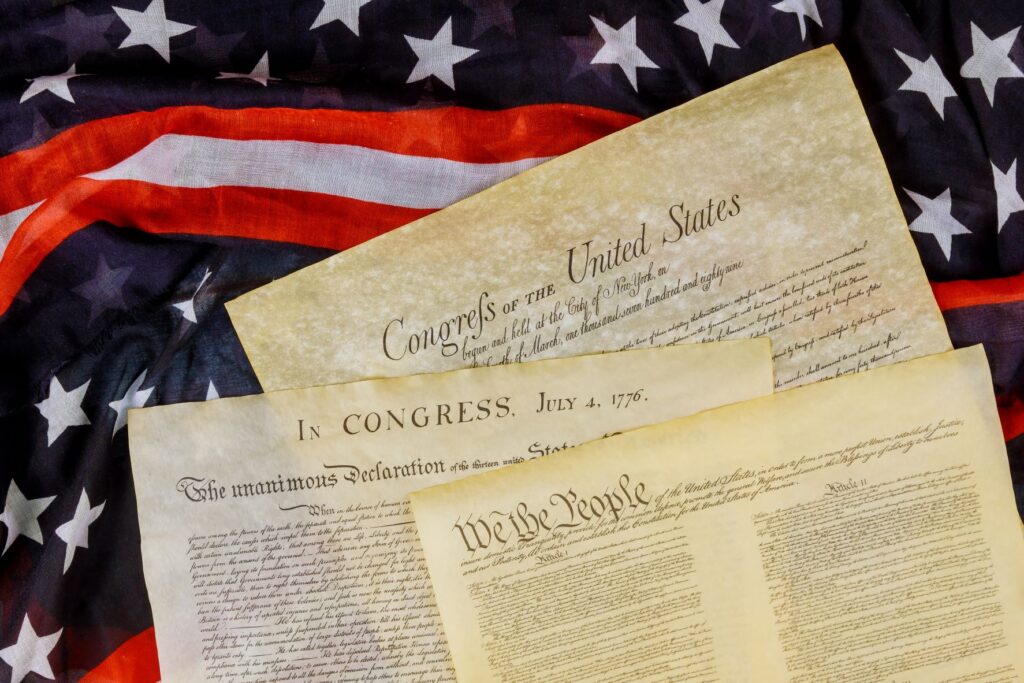When most people think of the U.S. Constitution, they think of things like the right to free speech or the right to bear arms. But in its first sentence, the Constitution sets forth its commitment to ensuring “domestic tranquility.” What does that mean for us today? We’ll discuss what this concept is and how it affects us as citizens.
The U.S. Constitution Established the Federal Government
The Constitution of the United States was written and approved by the original founding fathers in the late 1700s. It established a framework for creating one federal government that united the multiple colonies’ separate governments. In four handwritten pages, it sets out the organization and powers of three branches of the federal government and describes how citizens are represented by those branches.
The Constitution consists of three parts:
- The preamble
- The seven articles
- The amendments (including 1-10, known as the Bill of Rights, and 11-27, which have been added over time)
The preamble is a simple introductory paragraph that outlines the importance of the Constitution, why it was written, and the goals that it hopes to achieve as a nation:
We the people of the United States, in order to form a more perfect Union, establish justice, insure domestic tranquility, provide for the common defense, promote the general welfare, and secure the blessings of liberty to ourselves and our prosperity, do ordain and establish this Constitution for the United States of America.
The seven articles that follow set out the specific organization of the new federal government and the process for adopting the Constitution. Article I establishes the legislative branch, consisting of the House of Representatives (allocated to states based on their population) and the Senate (two representatives for each state). Article II describes the executive branch, including an elected President. Article III creates the judicial branch, establishing an independent Supreme Court and the authority for lower courts.
Article IV and Article VI concern the relationship of the states within the federal framework. Article IV provides that each state’s laws may be different but are enforceable nationwide, while Article VI provides that the federal law trumps individual state laws. Meanwhile, Article V gives the legislature (representing the states) the means to change the federal law. These provisions are directly targeted toward achieving the goal of tranquility across the nation.
What Is Domestic Tranquility?
Definitions of this concept vary. Most people likely think of peace at home -– that is, within a household. However, the drafters of the Constitution meant that it was the federal government’s primary responsibility to ensure peace and order in the land. Doing so meant bringing together many different groups who had formed 13 individual colonies based on diverse religious, political, and social beliefs.
After leaving behind a tumultuous European political climate, the founding statesmen of the U.S. wanted to create a central government that protected its citizens from outside threats. That protection involved keeping a watchful eye on other countries, in addition to having a solid relationship with other foreign allies.
The founders also wanted to ensure that their government encouraged its citizens to voice different opinions in gatherings or groups without government censure or oppression. They believed protecting citizens’ free expression was vital, and that the government has a duty to encourage peaceful marches or protests.
Domestic tranquility encompasses both of these goals. To protect the country from outside enemies, the Constitution allocates the federal government the power to negotiate, enter into treaties, and declare war on foreign powers. It also attempts to ensure peace among the individual states by giving the federal government the authority to arbitrate disputes and disagreements.
Balancing States’ Rights and Federal Authority
In an effort to encourage its adoption by the colonies, the Constitution allocated limited powers to the federal government and reserved most other powers to each colony as a separate state. The passage of the Tenth Amendment (as part of the Bill of Rights) specifically addressed this principle.
The Constitution contains measures to help promote harmony and prevent disagreements between the states. For example, it bars states from discriminating against citizens of other states because of their residency and prohibits enacting tariffs on goods traveling between states. It also requires states to ‘extradite‘ those accused of crimes to other states for trial.
Although the extradition measure helps states give ‘full faith and credit‘ to each other’s laws, as guaranteed in Article IV, it also creates the potential for significant conflict. What if one state refuses to enforce the law of another because it believes the law is immoral or unjust? In this situation, the Constitution gives the federal government the power to step in and arbitrate the dispute.
Promoting Domestic Tranquility in the Modern Era
As the U.S. has expanded in size and population, balancing the rights and wishes of its citizens is more difficult than ever. The White House notes that “[i]n order to prevent arbitrary changes, the process for making amendments [to the Constitution] is quite onerous.” This limits the ability of the federal government to change the document — for better or for worse. Preserving a peaceful, working republic requires a delicate balance between respecting each state’s autonomy and promoting the values of the nation as a whole.
